NIF Status Update – 2014
February
Successful ‘Mini-Campaigns’ Demonstrate New NIF Shot Cycle Efficiencies
The NIF Operations Team conducted a series of 10 back-to-back shots, including seven target shots, during the first week of February. The first week of these “mini-campaigns”—sets of experiments designed to be fired in a similar configuration to minimize facility changes while optimizing data return—implemented the first phase of a new scheduling paradigm to improve shot turnaround efficiency. NIF Operations Manager Bruno Van Wonterghem said the new continuous shot operation procedures proved to be very effective, and learning was noted for several activities including target alignment.
“I want to congratulate everyone on Team NIF for successfully executing the mini-campaigns of this past week to achieve seven target shots,” said Acting NIF&PS Principal Associate Director Jeff Wisoff. “This was an opportunity to beta-test new operations and scheduling concepts which will help us transform the NIF into a user facility that will take full advantage of its potential.”
Here are highlights of the February mini-campaigns:
- Three experiments in a Toto radiation hydrodynamics mini-campaign were completed in just 43½ hours on Feb. 3 and 4. The Toto campaign studies the implosion of a radiation-heated silicon dioxide foam capsule using a dual-backlighter configuration to measure implosion symmetry.
- Three more Toto experiments for the high energy density program were conducted on Feb. 7.
- A new “quartraum” (quarter hohlraum) platform shot was followed by a three-shot series to test reduction of stimulated Brillouin scattering (SBS) in a boron-coated gold hohlraum for the inertial confinement fusion program. The goal for the quartraum platform is to experimentally determine beam intensity distribution after power transfer. The target used a three-witness-plate design to view beams at several intensities. Good data were acquired throughout the mini campaigns; the final shot, on Feb. 8, concluded the successful sequence of seven target shots in one week.
- On Feb. 15-17, the team conducted four shots in the high-energy backlighter (HEBL) campaign using niobium (Nb) slit-projection backlighters. The campaign supports the NIF high energy density material strength effort. The goals of this mini-campaign were to measure Nb backlighter brightness, slit-projection spatial resolution, and the spectrum of the Nb backlighter. The first shot used laser beams without a pre-pulse or beam-smoothing continuous phase plates (CPPs). The second shot used beams without phase plates and had a pre-pulse; the third and fourth shots used beams with 400-micron CPPs, first with and then without pre-pulse. The shots were imaged with the High Energy Imaging Detection Instrument (HEIDI); data quality was excellent.
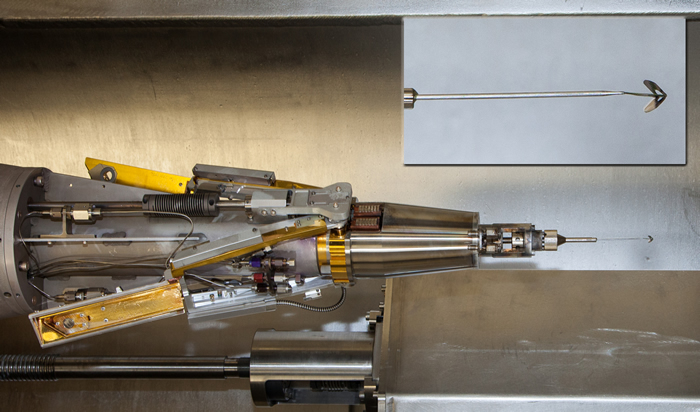 The unique “quartraum” target installed on the target positioner; the three “witness” surfaces intercept 12 upper and eight lower beams.
The unique “quartraum” target installed on the target positioner; the three “witness” surfaces intercept 12 upper and eight lower beams. 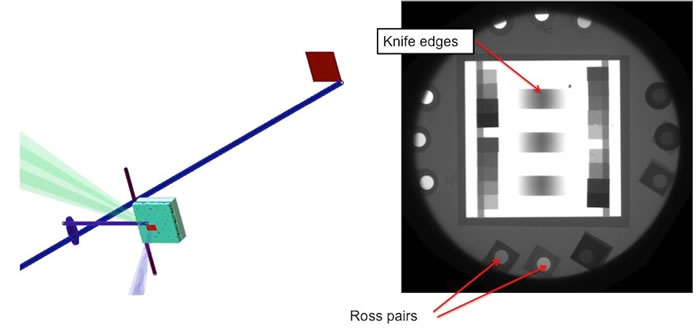 (Left) Diagram of the HEBL target. Phase plates were removed from the backlighter beams in the first two shots to give narrow spots that are tiled along the 15-micron slit of the backlighter assembly for slit-point-projection illumination of the knife-edge target on the right. (Right) HEIDI image of the second HEBL shot showing the knife-edge images in the center and Ross pair filters (pairs of foils) around the perimeter. The two sets of vertical filters around the images are transmission calibration filters.
(Left) Diagram of the HEBL target. Phase plates were removed from the backlighter beams in the first two shots to give narrow spots that are tiled along the 15-micron slit of the backlighter assembly for slit-point-projection illumination of the knife-edge target on the right. (Right) HEIDI image of the second HEBL shot showing the knife-edge images in the center and Ross pair filters (pairs of foils) around the perimeter. The two sets of vertical filters around the images are transmission calibration filters.  Target Area Coordinator Kevin Hood and Operator Rich Moore (not in photo) replace a grating debris shield in one of the NIF beams used for the fourth HEBL experiment on Feb. 17. The colors of the transmission grating can be seen behind the shield. (Credit: Juan Soto)
Target Area Coordinator Kevin Hood and Operator Rich Moore (not in photo) replace a grating debris shield in one of the NIF beams used for the fourth HEBL experiment on Feb. 17. The colors of the transmission grating can be seen behind the shield. (Credit: Juan Soto) Twenty NIF Experiments Completed in February
Including the three mini-campaigns, the NIF team conducted a total of 20 target experiments and 12 laser shots in February. Here are highlights of the other February experiments:
Hohlraum Gas-Fill Experiment—On Feb. 13, the team fired the first shot in an inertial confinement fusion gas-fill campaign to measure the in-flight shape of an undoped high-density carbon (diamond) capsule implosion in a near-vacuum hohlraum that is 17 percent larger than the standard hohlraum. The larger hohlraum is being tested to reduce effects of plasma filling in near-vacuum hohlraums for using them with longer laser pulses. Near vacuum hohlraums have high absorption and low scattering from laser-plasma instabilities that can produce fast electrons, a source of fuel preheat. Excellent data were acquired.
First System Generated Electromagnetic Pulse Experiments—The first two experiments in a System Generated Electromagnetic Pulse (SGEMP) campaign on NIF were conducted successfully on Feb. 20 and 21. The experiments are part of NIF’s National Security Applications mission with Sandia National Laboratories (SNL) and the UK’s Atomic Weapons Establishment (AWE) for electromagnetic simulation code validation.
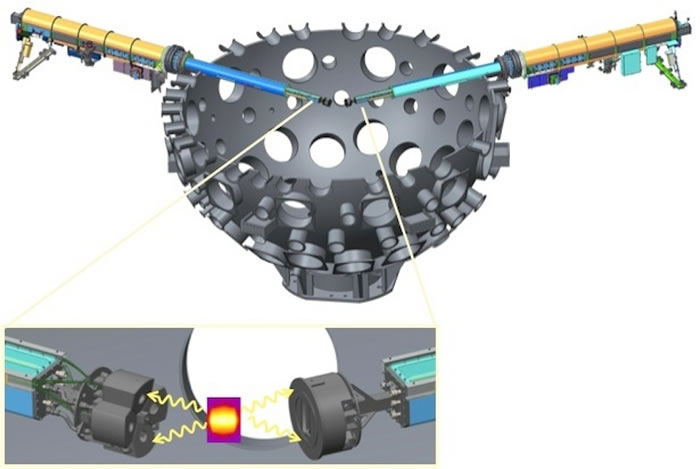 Configuration of the two diagnostic instrument manipulators for the first SGEMP experiments, showing the test objects mounted on the equatorial DIMs being driven by the x-ray emission from the target.
Configuration of the two diagnostic instrument manipulators for the first SGEMP experiments, showing the test objects mounted on the equatorial DIMs being driven by the x-ray emission from the target. The experiments used the NIF laser to create 7-keV (thousand-electron-volt) x-ray sources that drove electromagnetic current pulses similar to those generated at Sandia’s Z pulsed power facility in Albuquerque, NM. About 500 kilojoules of ultraviolet laser energy delivered by 160 NIF beams produced the x-ray sources that created electromagnetic responses in various test objects mounted on two NIF diagnostic instrument manipulators (DIMs). A large amount of diagnostic and data acquisition equipment was staged in the Target Bay for the tests. Five separate experiments contained in the diagnostics cassettes spanned a range of conditions important to code validation.
Excellent SGEMP data were recorded in both experiments, and the gas-fill system and in-situ calorimeters performed excellently. Small changes in the diagnostics between the first and second shots greatly improved facility diagnostic data quality. “Congratulations to you and the SGEMP team!’ NIF Director Jeff Atherton said in a message to Program Manager Kevin Fournier. “It’s great to have another National Security Applications campaign launched.”
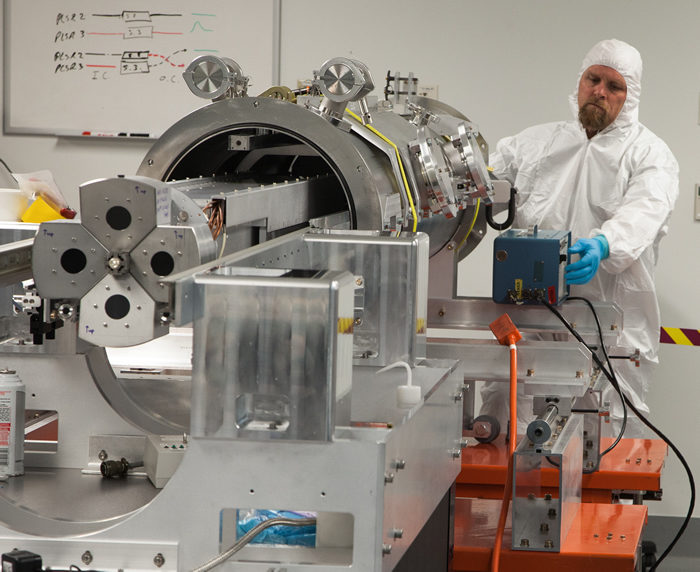 Diagnostics Technician Jesse Hamblen loads the SGEMP four-chamber object into a diagnostic handling unit. The round windows are vacuum barriers and also filter out low-level x rays.
Diagnostics Technician Jesse Hamblen loads the SGEMP four-chamber object into a diagnostic handling unit. The round windows are vacuum barriers and also filter out low-level x rays. Tantalum TARDIS Experiment—The NIF Team conducted a three-megabar (three million times Earth’s atmospheric pressure) tantalum target diffraction in-situ (TARDIS) experiment on Feb. 24. The experiment was designed to spectrally characterize and quantify the x-ray background associated with the TARDIS background platform. A tantalum target, a smaller-area x-ray source, and thicker germanium filters were used to reduce the high-energy background. Germanium and zirconium x-ray sources allowed for a direct comparison of diffraction efficiency. Four backlighter heater beams and 16 tantalum sample drive beams delivered 22 kilojoules of ultraviolet light to the target assembly. Excellent data were obtained on all primary diagnostics.
Thin-Shell Capsule Experiment—The next layered deuterium-tritium experiment was conducted on Feb. 25-26. This experiment was intended to optimize the hot-spot shape in a thin-shell, high-foot (high initial laser pulse) implosion using a nominal-length gold hohlraum. Changes from the last thin-shell capsule experiment included a 150-picosecond longer pulse “trough” following the initial pulse and a trough cone fraction reduced from 45 percent to 38 percent. The target had the same dimensions as in previous thin-shell experiments but used a thicker 45-nanometer “tent” supporting the capsule inside the hohlraum.
Re-emit Experiment—A high-foot “re-emit” shot was conducted on Feb. 27 to test early-time x-ray drive symmetry of a pulse similar to those used in the recent experiments that produced record yields enhanced by alpha-particle heating. The experiment also measured the level of high-energy, or “hot” electrons generated in the laser drive picket and the fraction of hot electrons reaching the capsule, as well as the amount of picket backscatter. Energies were slightly higher than the previous re-emit shot because it included the trough as well as the picket. All 192 beams delivered 42 kilojoules of ultraviolet light to the hohlraum in the three-nanosecond picket with 35 terawatts of peak power. Electron thermal waves from the inner laser beams were observed at late times for the first time on the polar view, providing data to validate simulations and verifying the operating window for the current re-emit design.
Ten-Picosecond X-ray Camera Installed on NIF
DIXI (Dilation X-ray Imager), an x-ray camera with a shutter time shorter than ten picoseconds (trillionths of a second), has been installed in the NIF Target Bay. Developed through a collaboration involving LLNL, General Atomics, and Kentech Instruments in the UK, the camera converts an x-ray image to an electron image, which is dilated, or stretched, and then coupled to a conventional shuttered electron camera.
This process results in a much shorter effective shutter speed and provides unprecedented x-ray time-resolution images that can help determine the implosion velocity and symmetry of NIF targets on experiments with significant neutron yield. Installation and commissioning of the DIXI concludes a significant development, design, and implementation effort to increase the NIF facility’s diagnostic capabilities.
 Diagnostics technician Roger Bopp installs the DIXI diagnostic unit in Level 2 of the NIF Target Bay with the help of Transport & Handling’s Eric Downing and Nick St. Hilaire (not shown).
Diagnostics technician Roger Bopp installs the DIXI diagnostic unit in Level 2 of the NIF Target Bay with the help of Transport & Handling’s Eric Downing and Nick St. Hilaire (not shown). Gray Blockers on NIF’s Lasers Pass an Important Test
Exposure to high-fluence laser light can cause some flaws in NIF’s optics to grow over time and affect performance. The programmable spatial shaper (PSS) system, installed on NIF in 2010, uses programmable “blockers” to introduce obscurations that reduce laser irradiation around selected flaw sites. The system allows power delivered to the target to be maximized while maintaining system longevity.
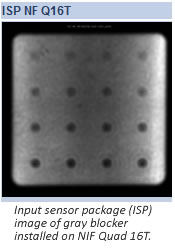
A newer feature of the PSS system is the use of variable transmission blockers, or “gray” blockers, which can reduce fluence below damage thresholds in the region of a flaw while allowing some of the energy that would be lost by using opaque black blockers to reach the target. Gray blockers also allow the flexibility to gradually increase laser power to a repaired optic when a black blocker is no longer needed. The unexposed region of the optic is conditioned through incremental power exposure, reducing power loss and boosting the fluence delivered to the target.
On Feb. 19, the NIF Team successfully tested gray blockers installed on four quads of NIF beamlines (16 beams) firing into the roving mirror diagnostic enclosure. “The gray blockers worked like a champ,” said Principal Investigator Mike Shaw. “Two quads were low energy, two high, so we could study the saturation effects. The measured transmission at the ISP (input sensor package) compared to request was within a few percent for all the blockers.”
“This is fantastic!” added NIF Deputy Doug Larson. “Another incredible piece of engineering, science and systems integration commissioned on the NIF. Thanks to the whole team that pulled this off.”




